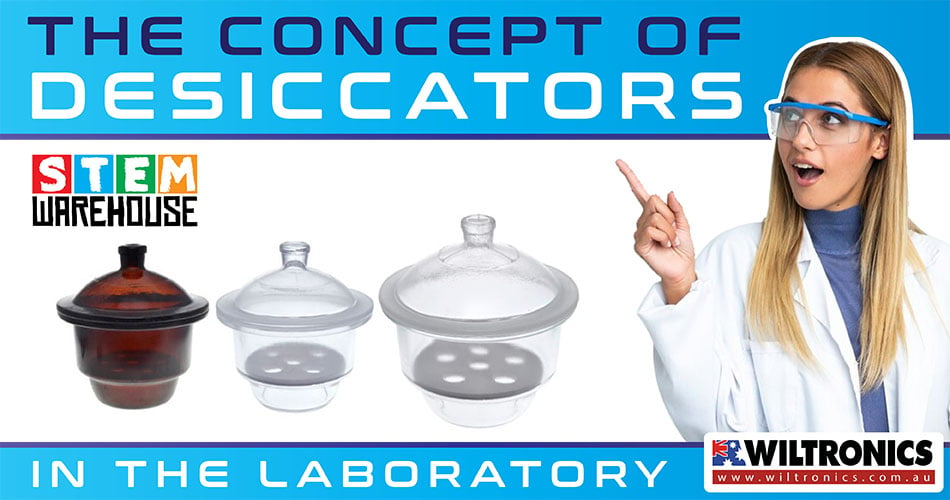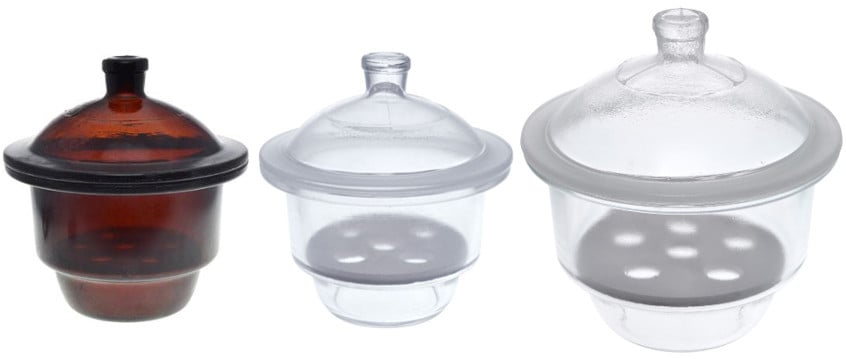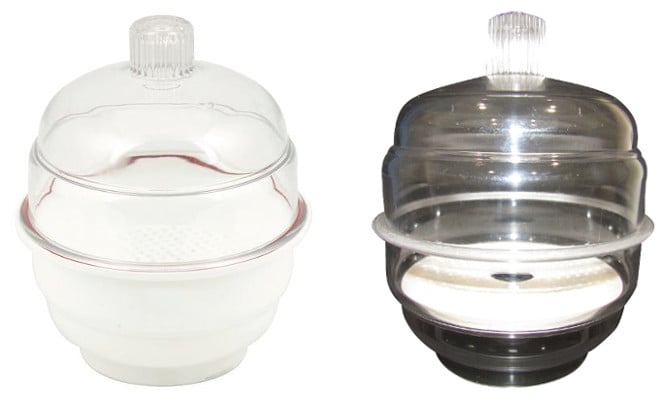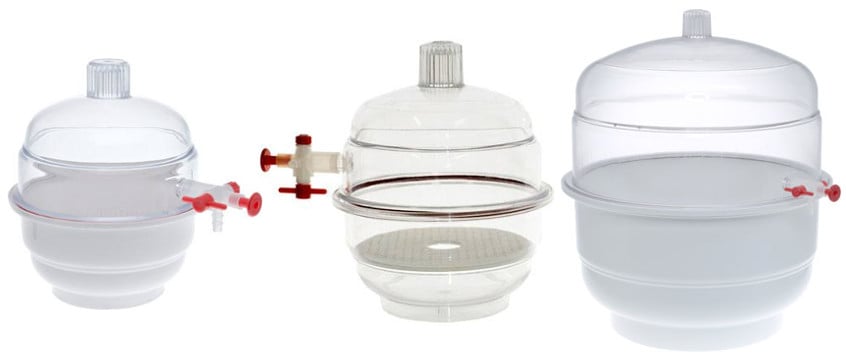The Concept of Desiccators in Laboratories
November 21, 2022

Heating supports most common lab operations, as does cooling and drying – cue desiccators.
Drying is a fundamental laboratory technique and crucial in chemical processing. Generally, it removes toxic residuals, stabilises moisture-sensitive materials, and sanitises them.
Freeze-drying also makes an excellent example. It eliminates water from a delicate biological product without sabotaging it.
Keeping components dry and not letting any moisture seep in is where desiccators come in. Besides being the right medium for the job, there is more to learn about this drying reactant tool.
Keep reading.
Desiccators in Laboratories
Desiccators are apparatuses designed to absorb the moisture present in a chemical substance. Utilised in various ways in the lab, they are a vital tool for drying reactants.
They are sealed containers used for drying samples under vacuum pressure. Also ideal for cooling heated objects and storing dry items.
Their working principle involves taking out all the humidity inside the desiccator itself. One ensures there are no particles of water left, so any chemicals never get wet, staying dry as much as possible.
A suitable drying agent helps maintain low humidity. It usually occupies the bottom part of the desiccator – supported by the base.
Common drying agents include anhydrous calcium chloride, calcium sulphate, and silica. A small cobalt indicator compound is also added. It turns pink from blue on the absorption of moisture. A sign that lets you know when to regenerate the desiccant.
A desiccator is only effective when properly sealed; some come with vacuum fittings. This feature pulls out the inside air for long-term storage of moisture-sensitive chemicals.
Desiccators can be made of glass, polypropylene, polycarbonate, or acrylic. But note that these are not the types but rather the materials available for the medium.
- Glass. Made from borosilicate glass, making glass desiccators are more robust. Even so, it is best to place them behind a screen under a vacuum to lessen the risk of shattering.
- Polycarbonate and polypropylene. Shatterproof and implosion proof, giving them high impact resistance. This material also allows desiccators to withstand high vacuum pressures.
- Acrylic. Clear and light sensitive. Ideal for storing anhydrous and hygroscopic biological and chemical compounds.
Types of Desiccators
There are four types of desiccators, and these are:
1. Standard
Standard units act as desiccant cartridges that require monitoring but are quite economical. They use reusable or disposable desiccant placed below or on any shelf.
The desiccant, as mentioned, removes moisture from the chamber. It will take in the moisture, and once saturated, you will have to replace or heat it to regenerate the desiccant.
As the unit is operated and monitored manually, it offers flexibility.
2. Vacuum
The vacuum desiccator requires a pump to remove any air or moisture from the chamber. The length of the vacuum process depends on the model.
Most incorporate an enclosure, vacuum pump, and a desiccant system. The said system helps achieve low RH values at sustained vacuum down to 29.92″ Hg.
If you need to remove air and humidity, use a vacuum desiccator. Thanks to the vacuum pump, it does the job in an instant.
A vacuum desiccator is also great at collecting dust and can be used as a standard desiccator.
3. Automatic
Automatic desiccators are fitted with electrical fans and heaters to prevent saturation. They are also continuously used to regenerate a dry atmosphere.
The automatic drying maintains a constant humidity of between 20% and 30%. This type requires minimal monitoring and is highly reliable but can be costly.
Even better, it is programmable and can operate on a present schedule. Using one lets you control humidity, and desiccation material replacement is less likely.
4. Gas purge
Gas purge desiccators use a slow and steady inert gas flow to extract moisture. The drying agent applied is nitrogen and argon.
They maintain a dry atmosphere within the desiccator at a faster rate. These units also create a dust-free environment and are great for clean rooms.
If you want fast humidity removal, a gas purge desiccator is your best bet.
Types of Desiccants
Generally, desiccants remove water from samples and air. These hygroscopic substances thus help induce or sustain a dry environment.
There are several types available, including the following:
- Gel. Non-toxic, non-inflammable and water-insoluble. Silica gel also absorbs and traps liquids, drying the air and samples. If heated around 85°C, it can be reused.
- Cartridge. Reusable cartridge desiccants are made of a rugged polyester felt bag and mylar cover. The silica beads with a Natrasorb TI indicator filling turn from blue to pink when saturated.
As for the disposable cartridges, they use silica gel that can be regenerated or disposed of. Some can come with a transparent polystyrene dish to check the colour change of the silica beads.
Accessories
- Desiccator plates. These hold crucibles or Petri dishes. They come in stainless steel or polypropylene materials. The stainless type is heat-resistant and rust-free. In contrast, polypropylene is semi-expanded and can only be used at room temperature.
- Stopcocks. Used on vacuum desiccators to help evacuate the liquid or gas from the inside. Stopcocks also make implosion less likely by reducing the pressure inside.
Safe Handling and Use of a Desiccator
If proper care is not exercised in the handling and use of desiccators, accidents can occur. A great example of this is the cover.
The cover is usually sealed to a desiccator’s body with a thin layer of silicone grease. This forms an airtight seal and requires safety measures in opening and putting it back.
The following are some precautions in handling one:
- Gently slide the cover horizontally until it starts moving. Grasp the knob with one hand while holding the base with the other. Apply more force to take it off completely.
- Do not lift the desiccator with the top knob. Instead, do it with both hands, holding the bottom and the cover.
- Slowly rotate the lid in both directions to ensure an airtight seal.
- Also, make sure the rim does not run out of grease, but at the same time, do not use an excessive amount. A thin, uniform film should do.
- Keep the lid upside down on removal but away from the workbench edge to prevent rollover.
- Place a hot substance carefully inside after removal from the hot air oven. Then, keep the crucible with the lift ajar for a couple of minutes. Next, close it by sliding it to expel hot air, avoiding the risk of getting the lid blown out. The closing also helps prevent vacuum formation later, which can make opening difficult.
Get Your Desiccators Here!
Check out this selection of glass, polypropylene, and polycarbonate desiccators. Available in both plain and vacuum variants.

Glass Desiccator
Product code: LG135x
Ideally used in science lab experiments to preserve moisture-sensitive items. It can also completely dry out a sample.
This glass desiccator set has a body, lid, and porcelain plate.

Plastic Desiccator
Product code: LP1351
This range features a knurled knob to make the top easy to handle. Available in various sizes, with either a transparent polycarbonate or opaque polypropylene base.

Vacuum Desiccator
Product code: LP1354
Features a stopcock with a clear polycarbonate top. For the base, you can choose either clear polycarbonate or white polypropylene.
There is a hole on the side of the lid for a stopcock, and the knurled knob makes the top easy to handle.
The Bottom Line
Desiccators remove moisture from a substance. They are common in laboratories where it is desirable to dry objects without heating them.
© Electrotech Brands Pty Ltd 2022


Write a Comment
You must be logged in to post a comment.